Information Systems & Big Data Analysis in Business Management
VerifiedAdded on 2023/06/08
|9
|2062
|273
Report
AI Summary
This report provides a comprehensive overview of big data analysis within the context of business management. It defines big data, outlines its key characteristics (volume, velocity, variety, veracity, and value), and discusses the significant challenges associated with its analysis, such as uncertainty in data management, the talent gap, data integration, synchronization needs, and deriving meaningful insights. The report further explores various techniques currently employed to analyze big data, including association rule learning, classification tree analysis, genetic algorithms, machine learning, regression analysis, sentiment analysis, and social network analysis. It provides examples of how big data technology can support business operations, such as improving guest experiences in hotels, optimizing emergency response in hospitals, and enhancing customer loyalty in the clothing industry. The report concludes by emphasizing the importance of big data in modern business and highlighting both its benefits and associated difficulties.
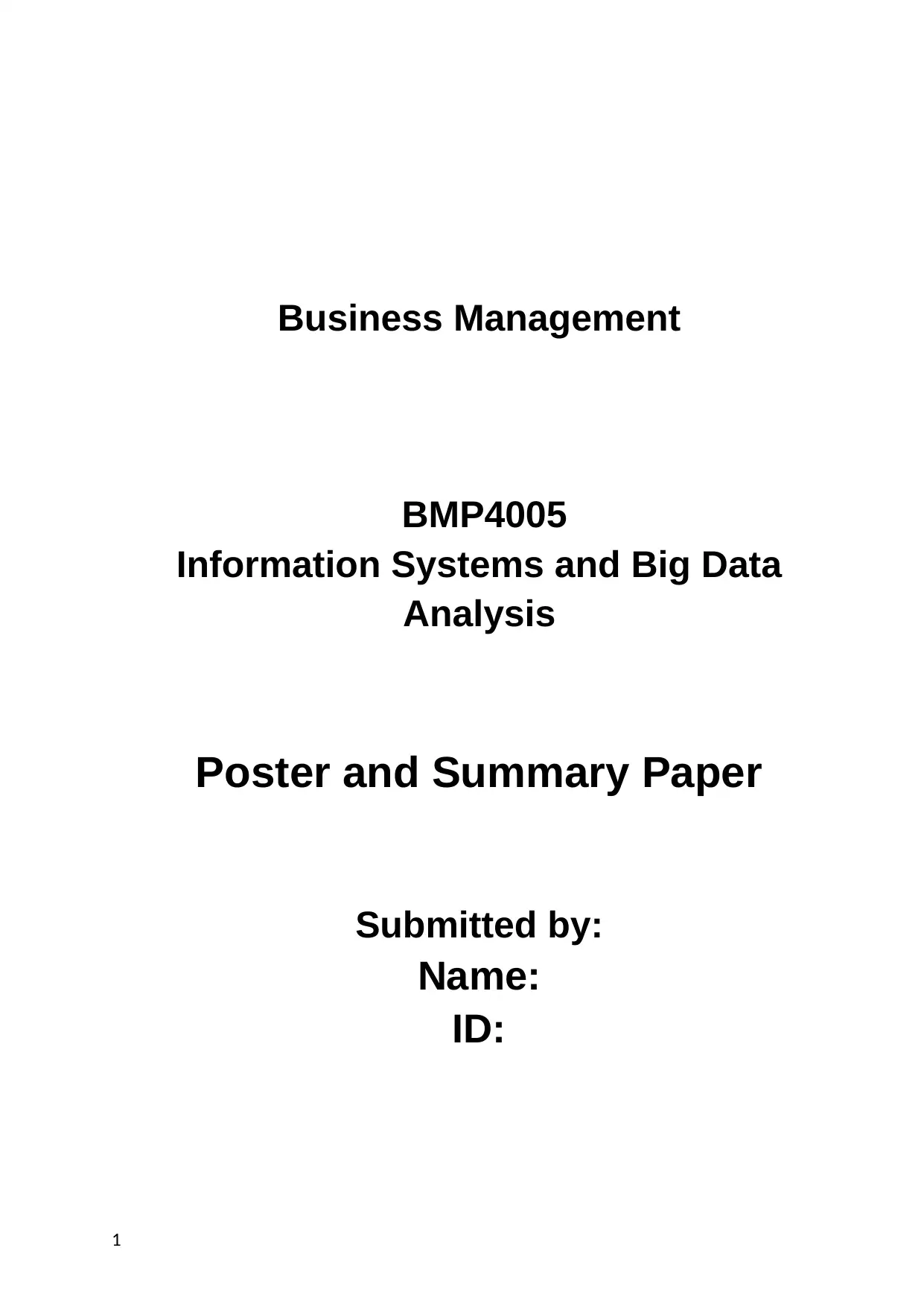
Business Management
BMP4005
Information Systems and Big Data
Analysis
Poster and Summary Paper
Submitted by:
Name:
ID:
1
BMP4005
Information Systems and Big Data
Analysis
Poster and Summary Paper
Submitted by:
Name:
ID:
1
Paraphrase This Document
Need a fresh take? Get an instant paraphrase of this document with our AI Paraphraser
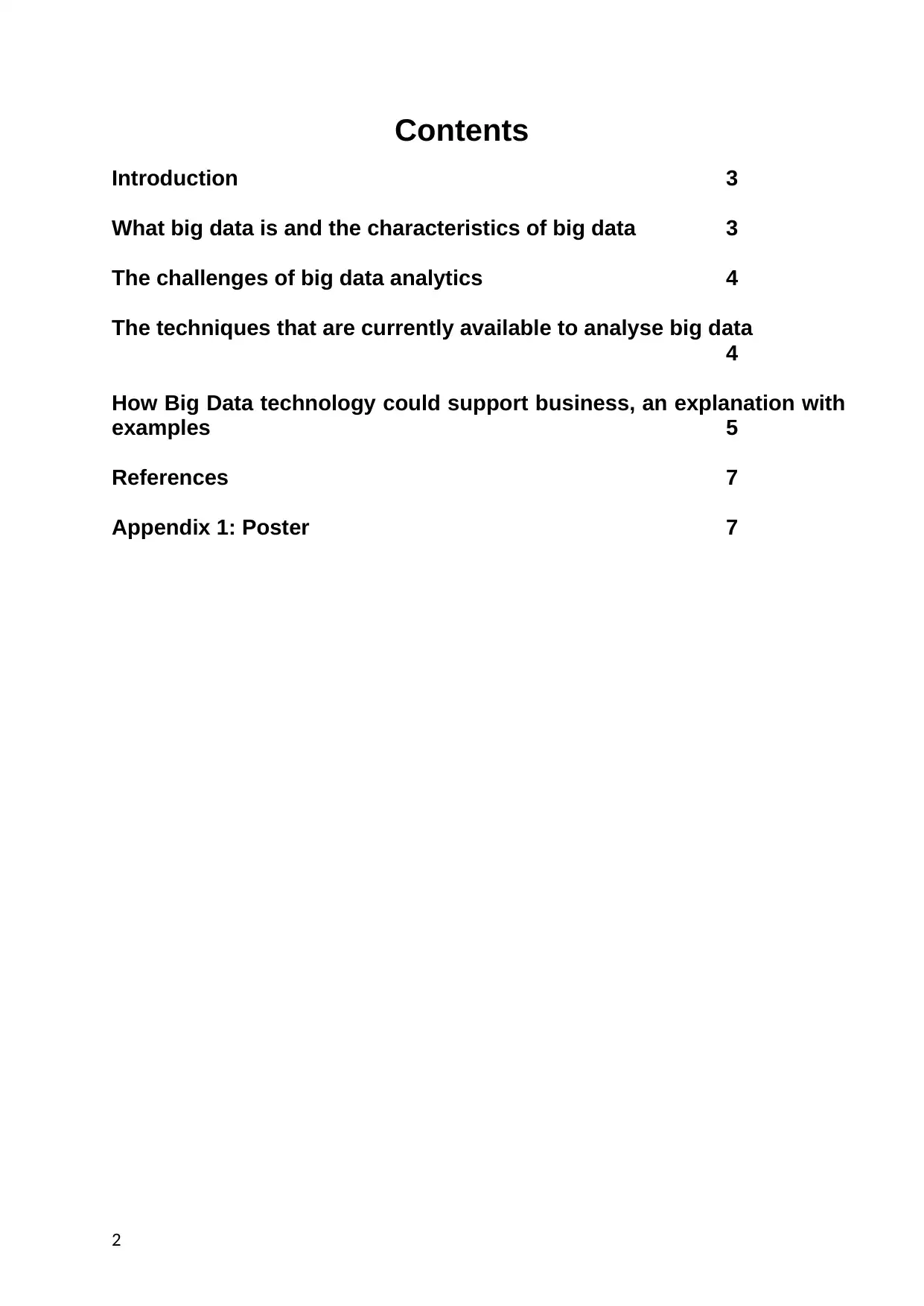
Contents
Introduction 3
What big data is and the characteristics of big data 3
The challenges of big data analytics 4
The techniques that are currently available to analyse big data
4
How Big Data technology could support business, an explanation with
examples 5
References 7
Appendix 1: Poster 7
2
Introduction 3
What big data is and the characteristics of big data 3
The challenges of big data analytics 4
The techniques that are currently available to analyse big data
4
How Big Data technology could support business, an explanation with
examples 5
References 7
Appendix 1: Poster 7
2
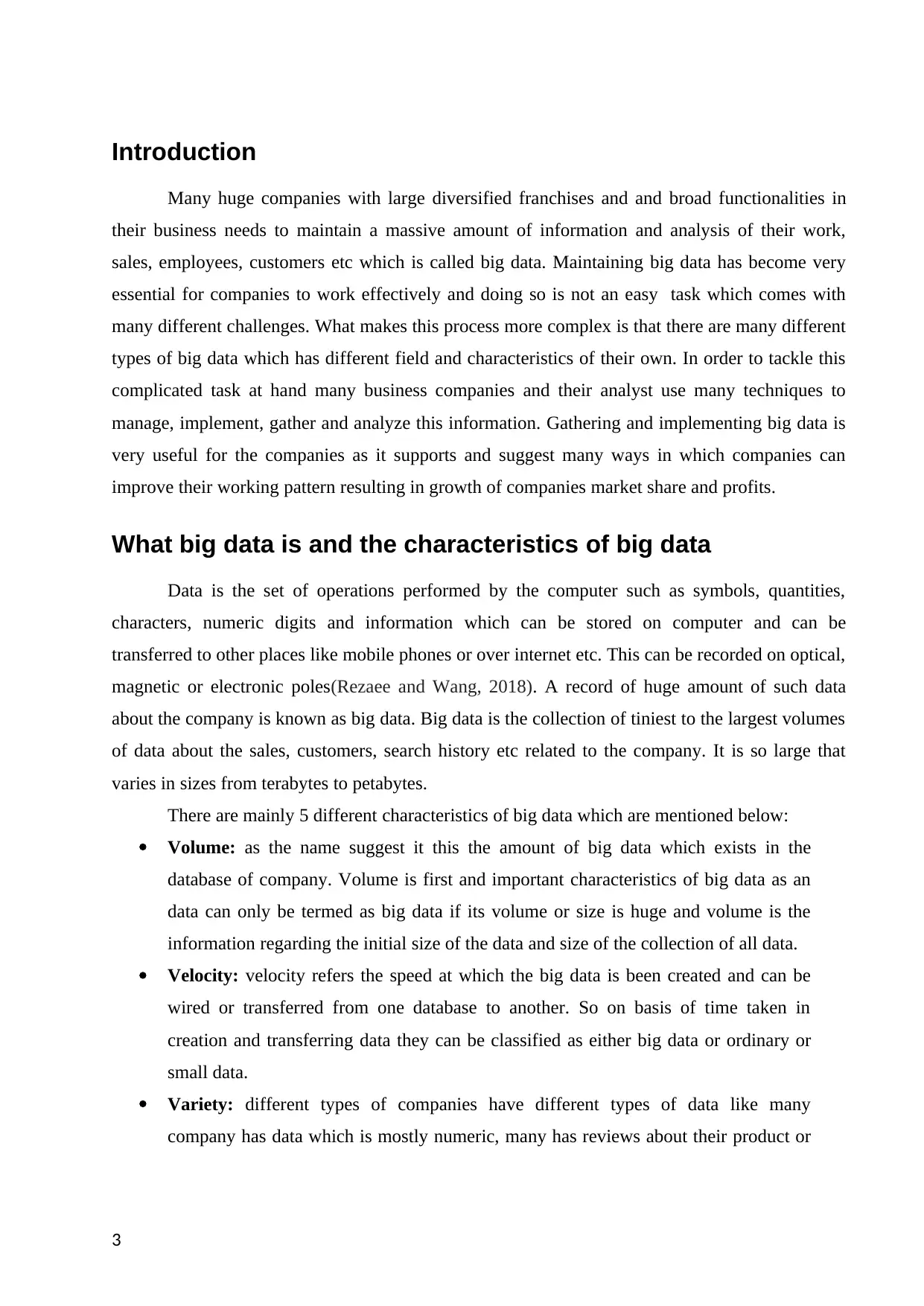
Introduction
Many huge companies with large diversified franchises and and broad functionalities in
their business needs to maintain a massive amount of information and analysis of their work,
sales, employees, customers etc which is called big data. Maintaining big data has become very
essential for companies to work effectively and doing so is not an easy task which comes with
many different challenges. What makes this process more complex is that there are many different
types of big data which has different field and characteristics of their own. In order to tackle this
complicated task at hand many business companies and their analyst use many techniques to
manage, implement, gather and analyze this information. Gathering and implementing big data is
very useful for the companies as it supports and suggest many ways in which companies can
improve their working pattern resulting in growth of companies market share and profits.
What big data is and the characteristics of big data
Data is the set of operations performed by the computer such as symbols, quantities,
characters, numeric digits and information which can be stored on computer and can be
transferred to other places like mobile phones or over internet etc. This can be recorded on optical,
magnetic or electronic poles(Rezaee and Wang, 2018). A record of huge amount of such data
about the company is known as big data. Big data is the collection of tiniest to the largest volumes
of data about the sales, customers, search history etc related to the company. It is so large that
varies in sizes from terabytes to petabytes.
There are mainly 5 different characteristics of big data which are mentioned below:
Volume: as the name suggest it this the amount of big data which exists in the
database of company. Volume is first and important characteristics of big data as an
data can only be termed as big data if its volume or size is huge and volume is the
information regarding the initial size of the data and size of the collection of all data.
Velocity: velocity refers the speed at which the big data is been created and can be
wired or transferred from one database to another. So on basis of time taken in
creation and transferring data they can be classified as either big data or ordinary or
small data.
Variety: different types of companies have different types of data like many
company has data which is mostly numeric, many has reviews about their product or
3
Many huge companies with large diversified franchises and and broad functionalities in
their business needs to maintain a massive amount of information and analysis of their work,
sales, employees, customers etc which is called big data. Maintaining big data has become very
essential for companies to work effectively and doing so is not an easy task which comes with
many different challenges. What makes this process more complex is that there are many different
types of big data which has different field and characteristics of their own. In order to tackle this
complicated task at hand many business companies and their analyst use many techniques to
manage, implement, gather and analyze this information. Gathering and implementing big data is
very useful for the companies as it supports and suggest many ways in which companies can
improve their working pattern resulting in growth of companies market share and profits.
What big data is and the characteristics of big data
Data is the set of operations performed by the computer such as symbols, quantities,
characters, numeric digits and information which can be stored on computer and can be
transferred to other places like mobile phones or over internet etc. This can be recorded on optical,
magnetic or electronic poles(Rezaee and Wang, 2018). A record of huge amount of such data
about the company is known as big data. Big data is the collection of tiniest to the largest volumes
of data about the sales, customers, search history etc related to the company. It is so large that
varies in sizes from terabytes to petabytes.
There are mainly 5 different characteristics of big data which are mentioned below:
Volume: as the name suggest it this the amount of big data which exists in the
database of company. Volume is first and important characteristics of big data as an
data can only be termed as big data if its volume or size is huge and volume is the
information regarding the initial size of the data and size of the collection of all data.
Velocity: velocity refers the speed at which the big data is been created and can be
wired or transferred from one database to another. So on basis of time taken in
creation and transferring data they can be classified as either big data or ordinary or
small data.
Variety: different types of companies have different types of data like many
company has data which is mostly numeric, many has reviews about their product or
3
⊘ This is a preview!⊘
Do you want full access?
Subscribe today to unlock all pages.

Trusted by 1+ million students worldwide
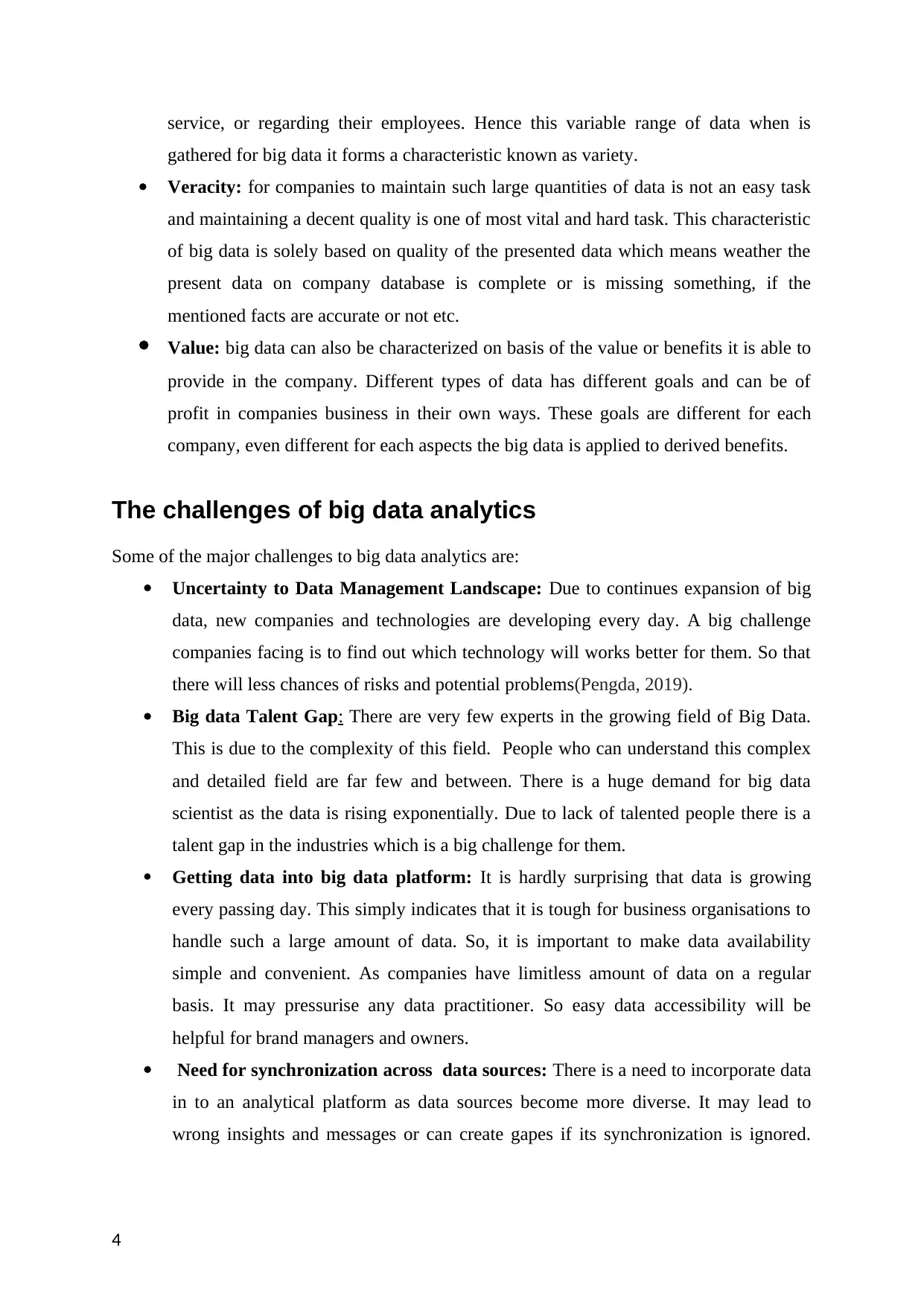
service, or regarding their employees. Hence this variable range of data when is
gathered for big data it forms a characteristic known as variety.
Veracity: for companies to maintain such large quantities of data is not an easy task
and maintaining a decent quality is one of most vital and hard task. This characteristic
of big data is solely based on quality of the presented data which means weather the
present data on company database is complete or is missing something, if the
mentioned facts are accurate or not etc.
Value: big data can also be characterized on basis of the value or benefits it is able to
provide in the company. Different types of data has different goals and can be of
profit in companies business in their own ways. These goals are different for each
company, even different for each aspects the big data is applied to derived benefits.
The challenges of big data analytics
Some of the major challenges to big data analytics are:
Uncertainty to Data Management Landscape: Due to continues expansion of big
data, new companies and technologies are developing every day. A big challenge
companies facing is to find out which technology will works better for them. So that
there will less chances of risks and potential problems(Pengda, 2019).
Big data Talent Gap: There are very few experts in the growing field of Big Data.
This is due to the complexity of this field. People who can understand this complex
and detailed field are far few and between. There is a huge demand for big data
scientist as the data is rising exponentially. Due to lack of talented people there is a
talent gap in the industries which is a big challenge for them.
Getting data into big data platform: It is hardly surprising that data is growing
every passing day. This simply indicates that it is tough for business organisations to
handle such a large amount of data. So, it is important to make data availability
simple and convenient. As companies have limitless amount of data on a regular
basis. It may pressurise any data practitioner. So easy data accessibility will be
helpful for brand managers and owners.
Need for synchronization across data sources: There is a need to incorporate data
in to an analytical platform as data sources become more diverse. It may lead to
wrong insights and messages or can create gapes if its synchronization is ignored.
4
gathered for big data it forms a characteristic known as variety.
Veracity: for companies to maintain such large quantities of data is not an easy task
and maintaining a decent quality is one of most vital and hard task. This characteristic
of big data is solely based on quality of the presented data which means weather the
present data on company database is complete or is missing something, if the
mentioned facts are accurate or not etc.
Value: big data can also be characterized on basis of the value or benefits it is able to
provide in the company. Different types of data has different goals and can be of
profit in companies business in their own ways. These goals are different for each
company, even different for each aspects the big data is applied to derived benefits.
The challenges of big data analytics
Some of the major challenges to big data analytics are:
Uncertainty to Data Management Landscape: Due to continues expansion of big
data, new companies and technologies are developing every day. A big challenge
companies facing is to find out which technology will works better for them. So that
there will less chances of risks and potential problems(Pengda, 2019).
Big data Talent Gap: There are very few experts in the growing field of Big Data.
This is due to the complexity of this field. People who can understand this complex
and detailed field are far few and between. There is a huge demand for big data
scientist as the data is rising exponentially. Due to lack of talented people there is a
talent gap in the industries which is a big challenge for them.
Getting data into big data platform: It is hardly surprising that data is growing
every passing day. This simply indicates that it is tough for business organisations to
handle such a large amount of data. So, it is important to make data availability
simple and convenient. As companies have limitless amount of data on a regular
basis. It may pressurise any data practitioner. So easy data accessibility will be
helpful for brand managers and owners.
Need for synchronization across data sources: There is a need to incorporate data
in to an analytical platform as data sources become more diverse. It may lead to
wrong insights and messages or can create gapes if its synchronization is ignored.
4
Paraphrase This Document
Need a fresh take? Get an instant paraphrase of this document with our AI Paraphraser
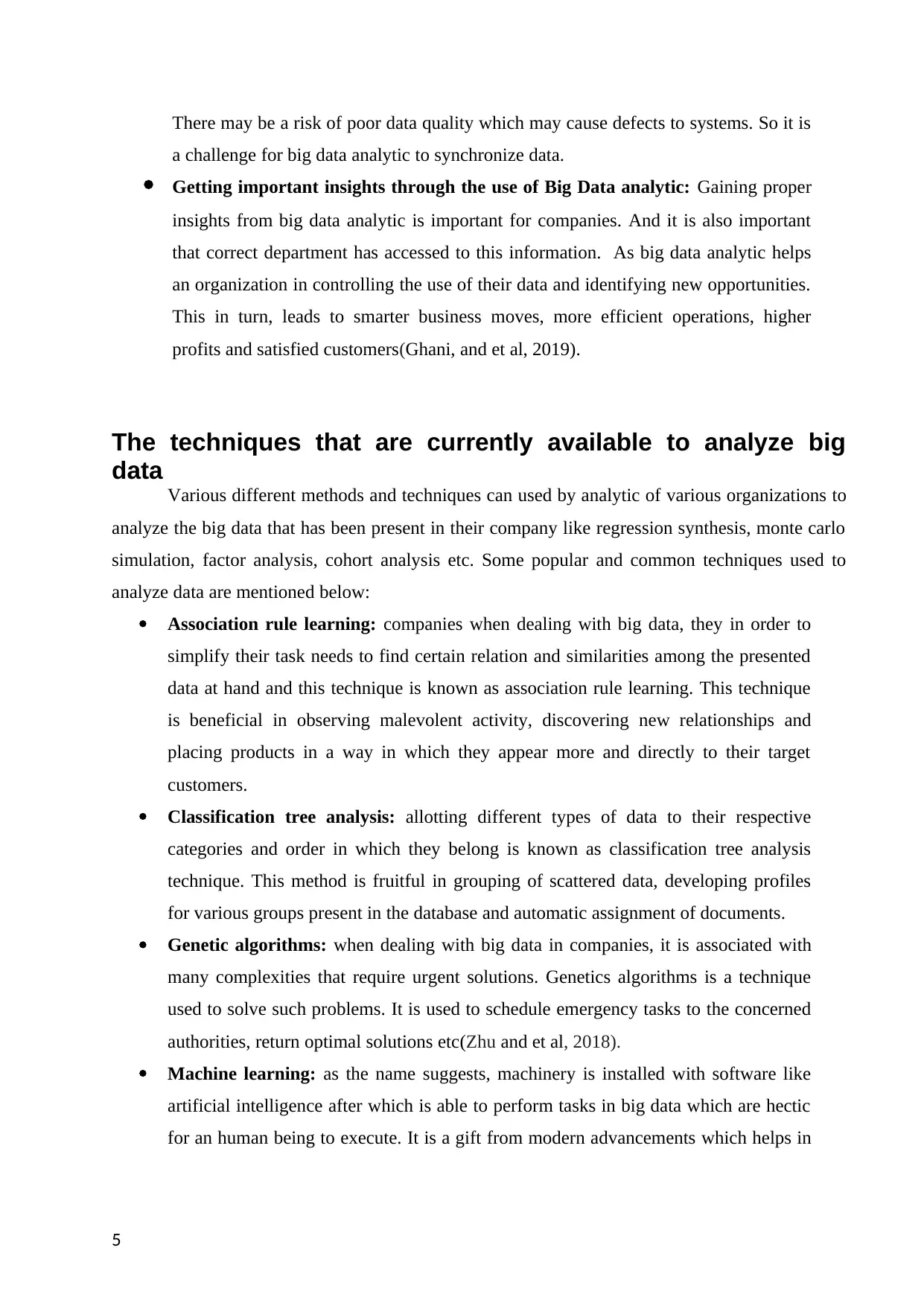
There may be a risk of poor data quality which may cause defects to systems. So it is
a challenge for big data analytic to synchronize data.
Getting important insights through the use of Big Data analytic: Gaining proper
insights from big data analytic is important for companies. And it is also important
that correct department has accessed to this information. As big data analytic helps
an organization in controlling the use of their data and identifying new opportunities.
This in turn, leads to smarter business moves, more efficient operations, higher
profits and satisfied customers(Ghani, and et al, 2019).
The techniques that are currently available to analyze big
data Various different methods and techniques can used by analytic of various organizations to
analyze the big data that has been present in their company like regression synthesis, monte carlo
simulation, factor analysis, cohort analysis etc. Some popular and common techniques used to
analyze data are mentioned below:
Association rule learning: companies when dealing with big data, they in order to
simplify their task needs to find certain relation and similarities among the presented
data at hand and this technique is known as association rule learning. This technique
is beneficial in observing malevolent activity, discovering new relationships and
placing products in a way in which they appear more and directly to their target
customers.
Classification tree analysis: allotting different types of data to their respective
categories and order in which they belong is known as classification tree analysis
technique. This method is fruitful in grouping of scattered data, developing profiles
for various groups present in the database and automatic assignment of documents.
Genetic algorithms: when dealing with big data in companies, it is associated with
many complexities that require urgent solutions. Genetics algorithms is a technique
used to solve such problems. It is used to schedule emergency tasks to the concerned
authorities, return optimal solutions etc(Zhu and et al, 2018).
Machine learning: as the name suggests, machinery is installed with software like
artificial intelligence after which is able to perform tasks in big data which are hectic
for an human being to execute. It is a gift from modern advancements which helps in
5
a challenge for big data analytic to synchronize data.
Getting important insights through the use of Big Data analytic: Gaining proper
insights from big data analytic is important for companies. And it is also important
that correct department has accessed to this information. As big data analytic helps
an organization in controlling the use of their data and identifying new opportunities.
This in turn, leads to smarter business moves, more efficient operations, higher
profits and satisfied customers(Ghani, and et al, 2019).
The techniques that are currently available to analyze big
data Various different methods and techniques can used by analytic of various organizations to
analyze the big data that has been present in their company like regression synthesis, monte carlo
simulation, factor analysis, cohort analysis etc. Some popular and common techniques used to
analyze data are mentioned below:
Association rule learning: companies when dealing with big data, they in order to
simplify their task needs to find certain relation and similarities among the presented
data at hand and this technique is known as association rule learning. This technique
is beneficial in observing malevolent activity, discovering new relationships and
placing products in a way in which they appear more and directly to their target
customers.
Classification tree analysis: allotting different types of data to their respective
categories and order in which they belong is known as classification tree analysis
technique. This method is fruitful in grouping of scattered data, developing profiles
for various groups present in the database and automatic assignment of documents.
Genetic algorithms: when dealing with big data in companies, it is associated with
many complexities that require urgent solutions. Genetics algorithms is a technique
used to solve such problems. It is used to schedule emergency tasks to the concerned
authorities, return optimal solutions etc(Zhu and et al, 2018).
Machine learning: as the name suggests, machinery is installed with software like
artificial intelligence after which is able to perform tasks in big data which are hectic
for an human being to execute. It is a gift from modern advancements which helps in
5
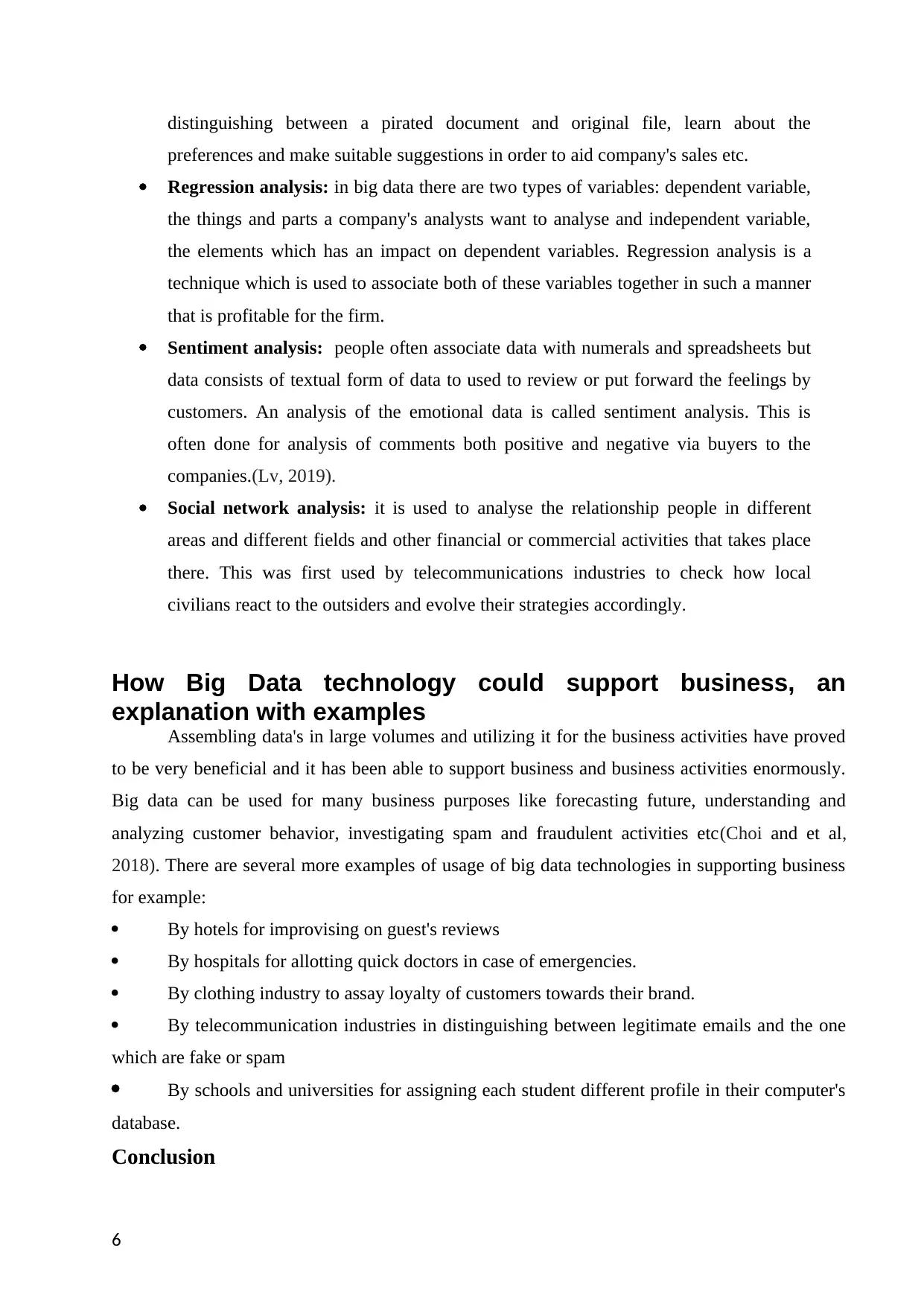
distinguishing between a pirated document and original file, learn about the
preferences and make suitable suggestions in order to aid company's sales etc.
Regression analysis: in big data there are two types of variables: dependent variable,
the things and parts a company's analysts want to analyse and independent variable,
the elements which has an impact on dependent variables. Regression analysis is a
technique which is used to associate both of these variables together in such a manner
that is profitable for the firm.
Sentiment analysis: people often associate data with numerals and spreadsheets but
data consists of textual form of data to used to review or put forward the feelings by
customers. An analysis of the emotional data is called sentiment analysis. This is
often done for analysis of comments both positive and negative via buyers to the
companies.(Lv, 2019).
Social network analysis: it is used to analyse the relationship people in different
areas and different fields and other financial or commercial activities that takes place
there. This was first used by telecommunications industries to check how local
civilians react to the outsiders and evolve their strategies accordingly.
How Big Data technology could support business, an
explanation with examples
Assembling data's in large volumes and utilizing it for the business activities have proved
to be very beneficial and it has been able to support business and business activities enormously.
Big data can be used for many business purposes like forecasting future, understanding and
analyzing customer behavior, investigating spam and fraudulent activities etc(Choi and et al,
2018). There are several more examples of usage of big data technologies in supporting business
for example:
By hotels for improvising on guest's reviews
By hospitals for allotting quick doctors in case of emergencies.
By clothing industry to assay loyalty of customers towards their brand.
By telecommunication industries in distinguishing between legitimate emails and the one
which are fake or spam
By schools and universities for assigning each student different profile in their computer's
database.
Conclusion
6
preferences and make suitable suggestions in order to aid company's sales etc.
Regression analysis: in big data there are two types of variables: dependent variable,
the things and parts a company's analysts want to analyse and independent variable,
the elements which has an impact on dependent variables. Regression analysis is a
technique which is used to associate both of these variables together in such a manner
that is profitable for the firm.
Sentiment analysis: people often associate data with numerals and spreadsheets but
data consists of textual form of data to used to review or put forward the feelings by
customers. An analysis of the emotional data is called sentiment analysis. This is
often done for analysis of comments both positive and negative via buyers to the
companies.(Lv, 2019).
Social network analysis: it is used to analyse the relationship people in different
areas and different fields and other financial or commercial activities that takes place
there. This was first used by telecommunications industries to check how local
civilians react to the outsiders and evolve their strategies accordingly.
How Big Data technology could support business, an
explanation with examples
Assembling data's in large volumes and utilizing it for the business activities have proved
to be very beneficial and it has been able to support business and business activities enormously.
Big data can be used for many business purposes like forecasting future, understanding and
analyzing customer behavior, investigating spam and fraudulent activities etc(Choi and et al,
2018). There are several more examples of usage of big data technologies in supporting business
for example:
By hotels for improvising on guest's reviews
By hospitals for allotting quick doctors in case of emergencies.
By clothing industry to assay loyalty of customers towards their brand.
By telecommunication industries in distinguishing between legitimate emails and the one
which are fake or spam
By schools and universities for assigning each student different profile in their computer's
database.
Conclusion
6
⊘ This is a preview!⊘
Do you want full access?
Subscribe today to unlock all pages.

Trusted by 1+ million students worldwide

This report concludes with the importance of big data in today's technologically advanced
and modern business scenario stating different types of big data that a business has. Along with
the benefits of big data this report also portrays the difficulties associated with the big data
analysis. To solve such problems different techniques which are used were also mentioned here.
Examples have supported the mentioned theories and helped in better understanding of big data
and its advantages.
7
and modern business scenario stating different types of big data that a business has. Along with
the benefits of big data this report also portrays the difficulties associated with the big data
analysis. To solve such problems different techniques which are used were also mentioned here.
Examples have supported the mentioned theories and helped in better understanding of big data
and its advantages.
7
Paraphrase This Document
Need a fresh take? Get an instant paraphrase of this document with our AI Paraphraser
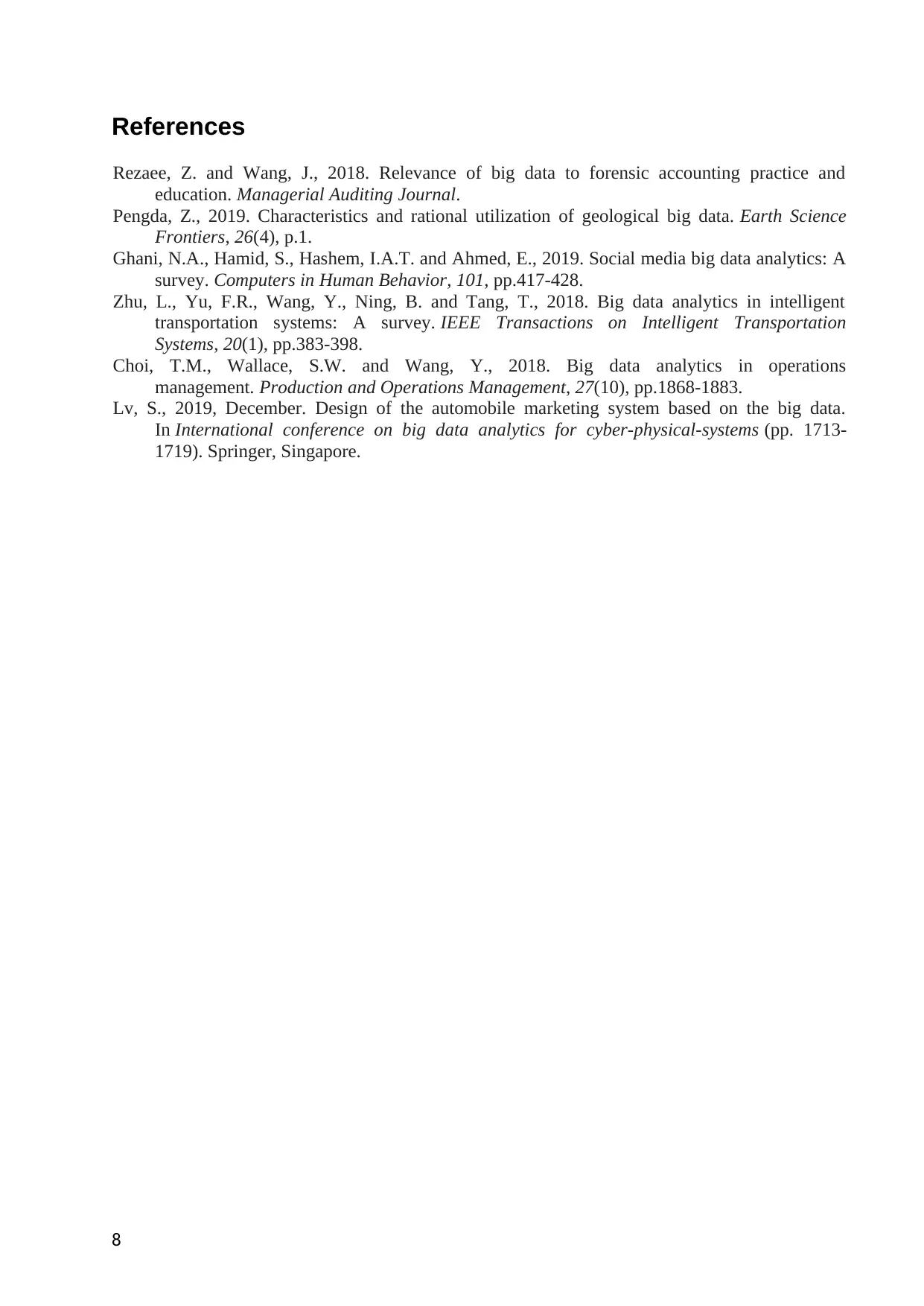
References
Rezaee, Z. and Wang, J., 2018. Relevance of big data to forensic accounting practice and
education. Managerial Auditing Journal.
Pengda, Z., 2019. Characteristics and rational utilization of geological big data. Earth Science
Frontiers, 26(4), p.1.
Ghani, N.A., Hamid, S., Hashem, I.A.T. and Ahmed, E., 2019. Social media big data analytics: A
survey. Computers in Human Behavior, 101, pp.417-428.
Zhu, L., Yu, F.R., Wang, Y., Ning, B. and Tang, T., 2018. Big data analytics in intelligent
transportation systems: A survey. IEEE Transactions on Intelligent Transportation
Systems, 20(1), pp.383-398.
Choi, T.M., Wallace, S.W. and Wang, Y., 2018. Big data analytics in operations
management. Production and Operations Management, 27(10), pp.1868-1883.
Lv, S., 2019, December. Design of the automobile marketing system based on the big data.
In International conference on big data analytics for cyber-physical-systems (pp. 1713-
1719). Springer, Singapore.
8
Rezaee, Z. and Wang, J., 2018. Relevance of big data to forensic accounting practice and
education. Managerial Auditing Journal.
Pengda, Z., 2019. Characteristics and rational utilization of geological big data. Earth Science
Frontiers, 26(4), p.1.
Ghani, N.A., Hamid, S., Hashem, I.A.T. and Ahmed, E., 2019. Social media big data analytics: A
survey. Computers in Human Behavior, 101, pp.417-428.
Zhu, L., Yu, F.R., Wang, Y., Ning, B. and Tang, T., 2018. Big data analytics in intelligent
transportation systems: A survey. IEEE Transactions on Intelligent Transportation
Systems, 20(1), pp.383-398.
Choi, T.M., Wallace, S.W. and Wang, Y., 2018. Big data analytics in operations
management. Production and Operations Management, 27(10), pp.1868-1883.
Lv, S., 2019, December. Design of the automobile marketing system based on the big data.
In International conference on big data analytics for cyber-physical-systems (pp. 1713-
1719). Springer, Singapore.
8
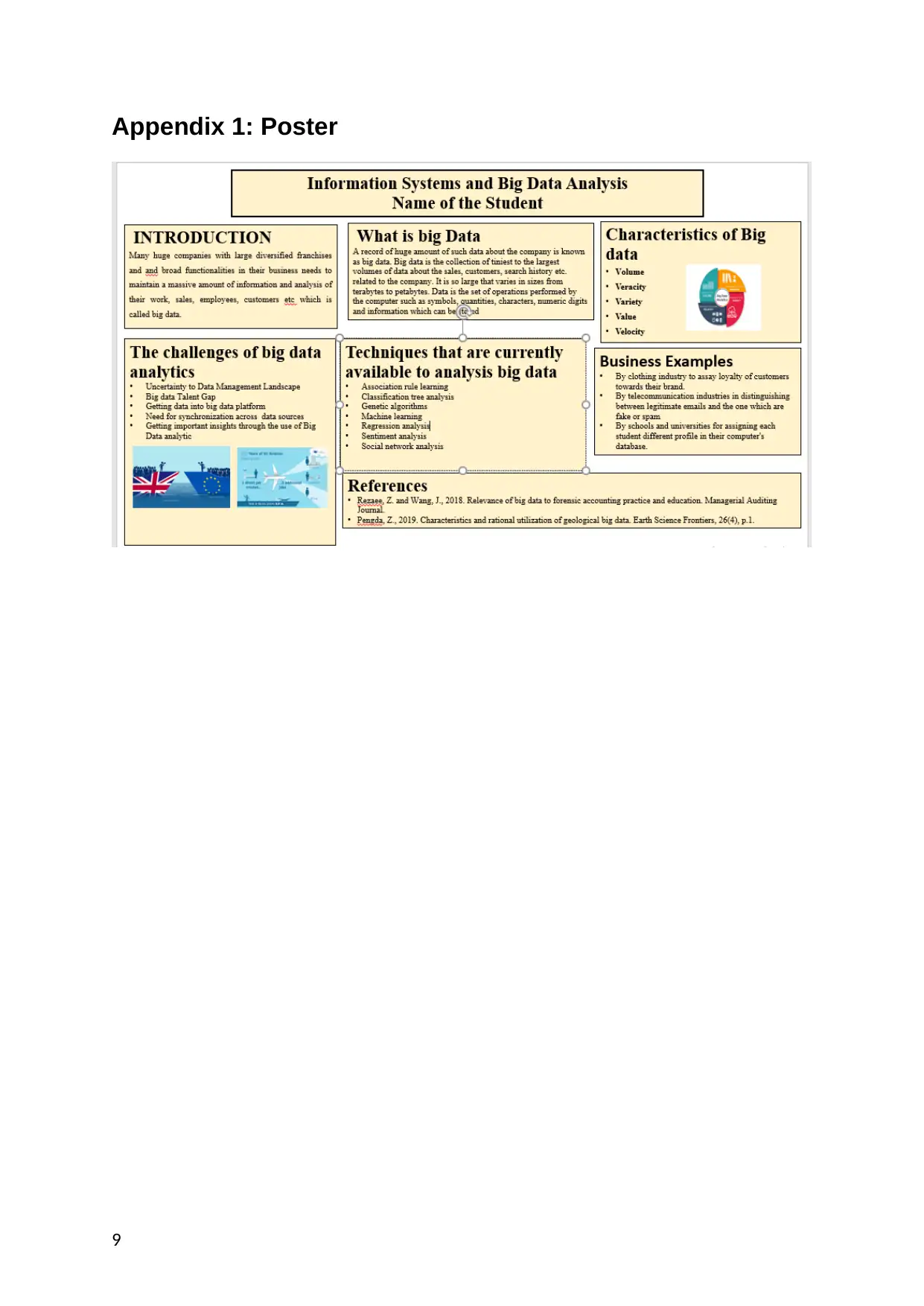
Appendix 1: Poster
9
9
⊘ This is a preview!⊘
Do you want full access?
Subscribe today to unlock all pages.

Trusted by 1+ million students worldwide
1 out of 9
Related Documents
Your All-in-One AI-Powered Toolkit for Academic Success.
+13062052269
info@desklib.com
Available 24*7 on WhatsApp / Email
![[object Object]](/_next/static/media/star-bottom.7253800d.svg)
Unlock your academic potential
Copyright © 2020–2025 A2Z Services. All Rights Reserved. Developed and managed by ZUCOL.


